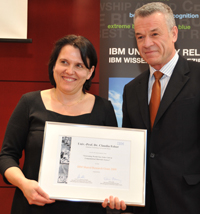
| Home | About Us | Contribute | Bookstore | Advertising | Subscribe for Free NOW! |
| News Archive | Features | Events | Recruitment | Directory |
News
19 February 2010
JGU’s Felser receives IBM Shared University Research Award in support of CIGS-based solar cell research
Johannes Gutenberg University (JGU) Mainz, Germany has received IBM’s Shared University Research Award, in recognition and support of Professor Dr Claudia Felser’s research on copper indium gallium diselenide (CIGS)-based solar cells. Felser, of the Institute of Inorganic Chemistry and Analytical Chemistry, received the award on 12 February 2010 during a ceremony at the university.
The award provides JGU with around $450,000 worth of state-of-the-art computer systems, which will be used for computer modelling new materials for solar cells.
 Picture: Professor Dr Claudia Felser receives IBM's Shared University Research Award from Erwin Jung, director of IBM Science Relations.
Picture: Professor Dr Claudia Felser receives IBM's Shared University Research Award from Erwin Jung, director of IBM Science Relations.
IBM awards the Shared University Research Award two to three times a year in order to support joint work with research institutions across the world. The award to JGU is founded on an almost 15-year long working relationship between IBM and Felser. Felser has been working for two years on computer modelling thin-film solar cells, in order to improve their efficiency and to reduce the proportion of environmentally harmful and rare earth elements such as cadmium and indium.
The research, led by Dr Thomas Gruhn, focuses on CIGS solar cells, which to date show an efficiency of almost 20%. However, a disadvantage is that until now, no appropriate material has been discovered to replace the use of the environmentally harmful heavy metal cadmium in CIGS solar cells. The Mainz group hopes to find a replacement material made from so-called half-Heusler compounds. Half-Heusler compounds and the structurally similar Heusler materials are intermetallic compounds made from three elements that form a cubic crystal structure. Felser is one of the world’s leading specialists in this field.
The new computer facilities will make it possible to expand the search for optimal materials to other potential materials, and to predict their behaviour with the help of computer modelling. A further aim is to increase the efficiency of thin-film solar cells. In this endeavour, CIGS solar cells present scientists with a riddle that has remained unsolved for many, the indium/gallium puzzle. The ratio of the two elements to one another is critical to the efficiency of solar cells. In practice, solar cells with a higher proportion of indium show a higher efficiency than solar cells with a higher proportion of gallium, in contrast to scientists’ predictions. JGU says that the reason for this may soon be demonstrated by new computer simulations, and that it might then be possible to further improve the already high efficiency levels of CIGS solar cells.
Felser has been a professor at JGU since 2003. She is the spokesperson of the "New Materials with High Spin Polarization" research unit of the German Research Foundation and director of the "Materials Science in Mainz" Graduate School. In 2001, Felser received the State Order of Merit of Rhineland-Palatinate for establishing a laboratory for pupils at Mainz University. In autumn 2009, she received the title of ‘Distinguished Lecturer’ from the American IEEE Magnetics, for her work on raw materials in spintronics.
![]() Search: CIGS
Search: CIGS
Visit: www.uni-mainz.de/eng/13352.php